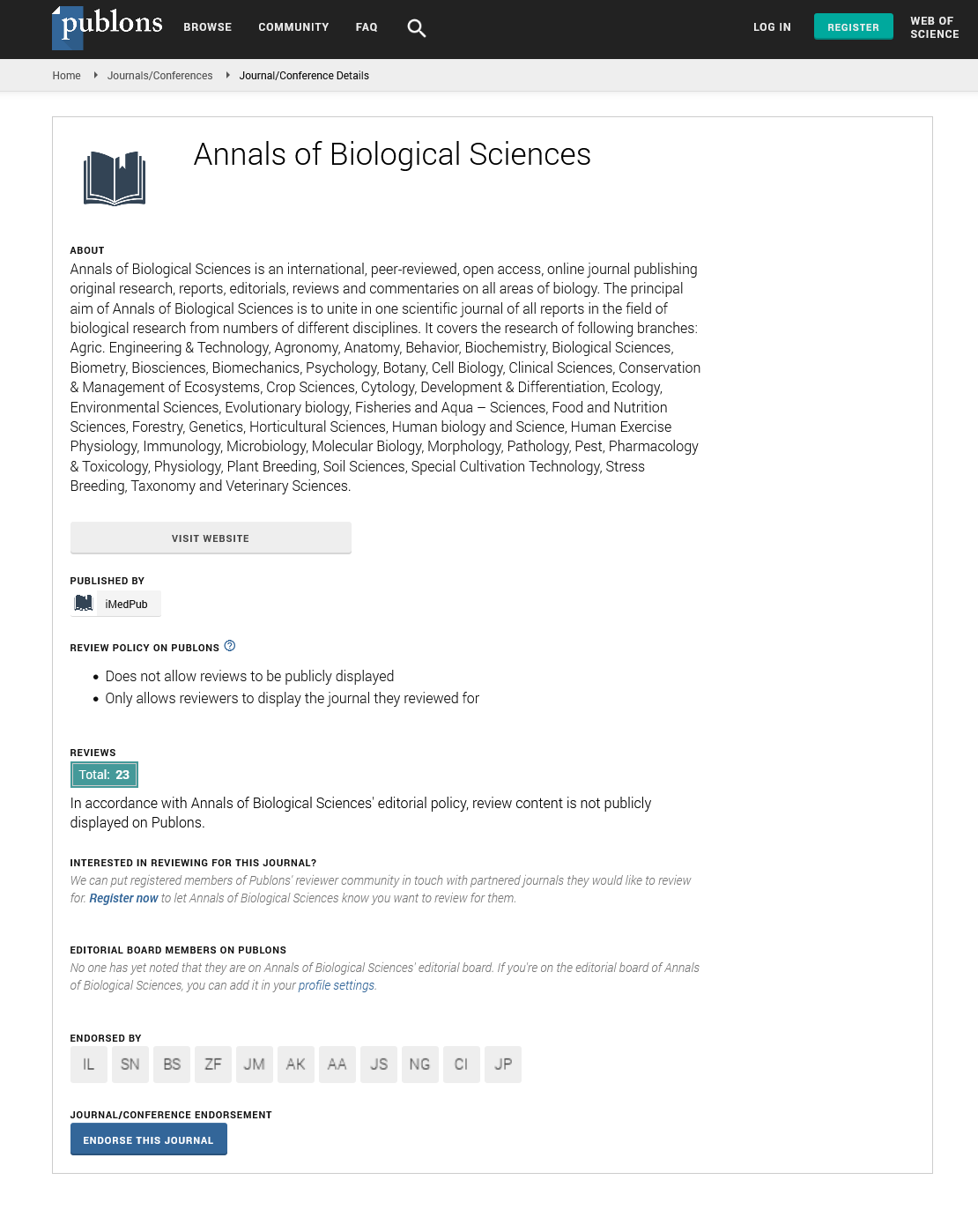ISSN : 2348-1927
Annals of Biological Sciences
Abstract
Dulaglutide Improves Aluminum Chloride Induced Cognitive Dysfunction Diabetes Associated Alzheimer's Rat Model
Background: Type-2 diabetes is an etiological factor for Alzheimer’s. GLP-1 analogues were prescribed in treating type-2 diabetes mellitus, where the presence of GLP-1 receptors in brain also makes it a potential target for Alzheimer’s disease.
Aim: The aim of the study is to evaluate the neuroprotective effect of dulaglutide in aluminum chloride induced cognitive dysfunction in type-2 diabetes associated Alzheimer’s experimental rats by conducting behavioral studies, estimating the biochemical parameters and histopathological changes involved in the pathogenesis of the disease.
Objective: To evaluate the effect of GLP-1 analogue on learning and memory in Aluminum chloride induced Alzheimer’s disease in type-2 diabetic rats by using physical and biochemical methods.
Methods: Study design included male wistar rats made into 6 groups (n=9) where group 1 was treated as vehicle control, group 2 as diabetic control, group 3 as Alzheimer’s control, group 4 as diabetic and Alzheimer’s control, group 5 as standard that received donepezil 3 mg/BSA p.o, group 6 as test that received dulaglutide 1.5 mg/BSA. Type-2 diabetes was induced by administrating Nicotin Amide (NA) 120 mg/kg i.p followed by Streptozotocin (STZ) 30 mg/kg i.v. Alzheimer’s was induced by administrating aluminum chloride 100 mg/kg oral after 3 days of diabetes induction. This study was conducted for a period of 42 days. Behavioral assessments were made on day 0,21 and 42 using elevated plus maze, Y-maze, Actophotometer and Novel Object Recognition test (NOR) followed by the estimation of biochemical parameters such as blood glucose, protein content, brain specific Creatine Kinase (CK-BB), Acetyl Choline (ACh), Acetyl Cholin Esterase (AChE), Lipid Per Oxidation (LPO), Super Oxide Dismutase (SOD), reduced Glutathione (GSH) and Catalase (CAT) activity.
Results: Results manifested that Dulaglutide ( 1.5 mg/BSA) improved cognitive function in rats providing a significant reduction in blood glucose levels (114.65 ± 8.87 mg/dL), protein content (8.907 ± 7.18 mg/g), CK-BB (219.57 ± 9.23 U/L), acetylcholinesterase (AChE) activity (0.593 ± 5.83 µM/mg) and lipid peroxidation (2.78 ± 7.69 µM/mg) and also presented a significant improvement in Acetyl Choline (ACh) levels (7.321 ± 7.52 µM/mg), SOD (51.14 ± 10.42 U/mg), GSH (11.09 ± 10.68 µM/mg) and catalase activity (1.12 ± 11.75 µM/mg) when compared with diseased controls which were analyzed using one-way ANOVA followed by Post-Hoc Tukey’s test with a significant variance of P<0.05. Histopathological study of hippocampus with congo red and Hematoxylin and Eosin (H&E) stain revealed a decrease in the plaque deposition and degenerated neurons respectively.
Conclusion: These findings from the study manifest the neuroprotective effect of dulaglutide against aluminum chloride induced cognitive dysfunction in Type-2 diabetic Alzheimer’s rats.
Author(s): Vkk Mandlem, Vazra Sravani Ka, GSN Koteswara Rao, Ravi Mannec and Ramoji Kosurud
Abstract | Full-Text | PDF
Share This Article
Google Scholar citation report
Citations : 406
Annals of Biological Sciences received 406 citations as per Google Scholar report
Annals of Biological Sciences peer review process verified at publons
Abstracted/Indexed in
- Google Scholar
- China National Knowledge Infrastructure (CNKI)
- WorldCat
- Publons
- ROAD
- Secret Search Engine Labs
Open Access Journals
- Aquaculture & Veterinary Science
- Chemistry & Chemical Sciences
- Clinical Sciences
- Engineering
- General Science
- Genetics & Molecular Biology
- Health Care & Nursing
- Immunology & Microbiology
- Materials Science
- Mathematics & Physics
- Medical Sciences
- Neurology & Psychiatry
- Oncology & Cancer Science
- Pharmaceutical Sciences
